
The 82nd Airborne Division is an airborne infantry division of the United States Army specializing in parachute assault operations into hostile areas with a U.S. Department of Defense mandate to be "on-call to fight any time, anywhere" at "the knife's edge of technology and readiness." Primarily based at Fort Liberty, North Carolina, the 82nd Airborne Division is part of the XVIII Airborne Corps. The 82nd Airborne Division is the U.S. Army's most strategically mobile division.
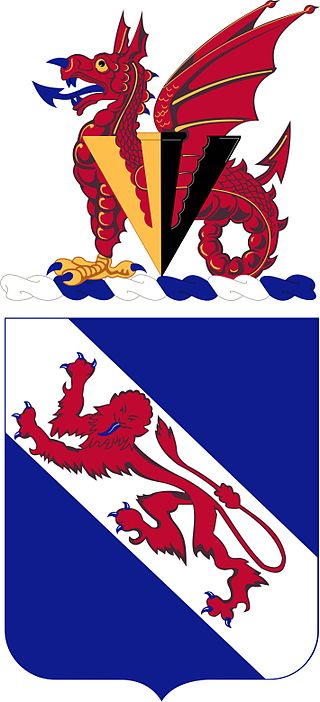
The 508th Infantry Regiment is an airborne infantry regiment of the United States Army, first formed in October 1942 during World War II. The 508th is a parent regiment under the U.S. Army Regimental System, and two battalions from the regiment are currently active: the 1st Battalion, 508th Parachute Infantry Regiment is assigned to the 3rd Brigade Combat Team, 82nd Airborne Division, and the 2nd Battalion, 508th Parachute Infantry Regiment is assigned to the 2nd Brigade Combat Team, 82nd Airborne Division. The regiment served in combat during World War II, and regimental elements have served in combat in the Dominican Republic, Vietnam, Grenada, Panama, Iraq and Afghanistan.
The 2nd Brigade Combat Team, 1st Infantry Division, also known as the Dagger Brigade, is a maneuver brigade combat team in the 1st Infantry Division of the U.S. Army stationed in Fort Riley, Kansas.
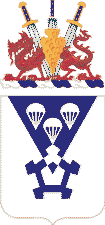
The 503rd Infantry Regiment, formerly the 503rd Parachute Infantry Regiment and the 503rd Airborne Infantry Regiment, is an airborne infantry regiment of the United States Army. The regiment served as an independent regiment in the Pacific War during World War II; at Fort Campbell, Kentucky; in Okinawa, Japan; and in Germany. Regimental elements have been assigned to the 2nd Infantry Division, the 11th Airborne Division, the 24th Infantry Division, 25th Infantry Division, the 82nd Airborne Division, 101st Airborne Division, and the 173rd Airborne Brigade Combat Team. Regimental elements have participated in campaigns in the Vietnam War, Operation Enduring Freedom–Afghanistan, and Operation Iraqi Freedom. The regiment claims 15 Medal of Honor recipients: two from World War II, ten from Vietnam, and three from Afghanistan. A parent regiment under the U.S. Army Regimental System. The regiment's 1st and 2nd Battalions are active, assigned to the 173rd Airborne Brigade, based at Caserma Ederle, Vicenza, Italy. The 3rd and 4th Battalions as well as Companies E, F, G, H, and I have been inactived.

The 325th Infantry Regiment is an infantry regiment of the 82nd Airborne Division. The regiment serves as the 82nd Airborne's light infantry parachute insertion fighting force of the United States Army, with a long and distinguished history, having taken part in World War I, World War II, the Vietnam War, the invasions of Grenada and Panama, as well as the Gulf and Iraq Wars. The subordinate units of the regiment constitute the bulk of the infantry elements assigned to the 2nd Infantry Brigade Combat Team, 82nd Airborne Division.

The 505th Parachute Infantry Regiment, originally the 505th Infantry Regiment, is an airborne infantry regiment of the United States Army, one of four infantry regiments of the 82nd Airborne Division of the United States Army, with a long and distinguished history.

The 504th Infantry Regiment, originally the 504th Parachute Infantry Regiment, is an airborne forces regiment of the United States Army, part of the 82nd Airborne Division, with a long and distinguished history. The regiment was first formed in mid-1942 during World War II as part of the 82nd Airborne Division and saw service in Sicily, Italy, Anzio, the Netherlands, Belgium and Germany.
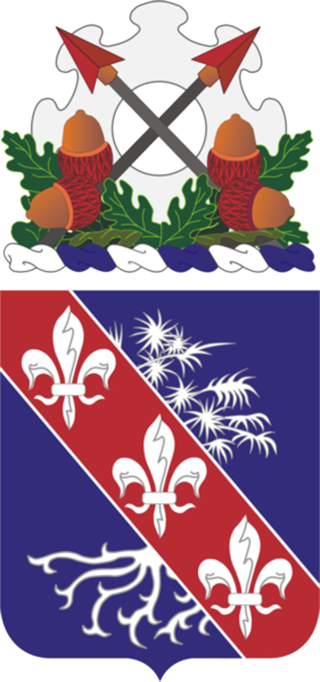
The 327th Infantry Regiment is an infantry regiment of the 101st Airborne Division of the United States Army. During World War II, the 327th was a glider-borne regiment of the 101st Airborne Division. It fought during World War I as part of the 82nd Division. It has also been deployed in the Vietnam War, Gulf War, and most recently to Iraq and Afghanistan. The song "Glider Rider" describes (humorously) some of the slights that glider-borne troops felt they received from the Army during World War II; though the regiment's public fame rose with the 1949 movie Battleground about the Siege of Bastogne in late 1944.

The 1st Battalion, 320th Field Artillery Regiment is the field artillery battalion assigned to the 2nd Brigade Combat Team, 101st Airborne Division. The battalion has been assigned to the 82nd Airborne Division, 11th Airborne Division and 101st Airborne Division. The battalion has participated in World War I, World War II, Operation Power Pack, Operation Urgent Fury, Operation Desert Storm, Operation Iraqi Freedom, Operation Enduring Freedom, and Operation Inherent Resolve.

The 64th Brigade Support Battalion, nicknamed "Mountaineers," is a United States Army support battalion, assigned to the 3rd Armored Brigade Combat Team, 4th Infantry Division in Fort Carson, Colorado.
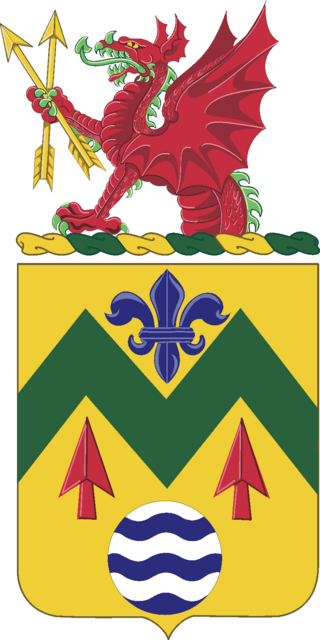
The 528th Support Battalion is a battalion of the United States Army. The 528th Support Battalion's mission is to provide rapidly deployable CSS and HSS to ARSOF as directed. The 528th Support Battalion's strengths lie in its capability to support ARSOF-unique and low-density weapons and vehicles. The 528th complements [organic] 22 ARSOF CSS, HSS, and signal units. The support battalion consists of a headquarters and main support company (HMSC), three forward support companies and may receive augmentation from Theater Army. As part of Army Special Operations Command the unit, along with the 112th Signal Battalion, is tasked to provide full logistical support to Army Special Operations Forces forming along with several other units what was known as Special Operations Support Command, later reorganized as the 528th Sustainment Brigade (A). The Brigade Troops Battalion includes a wide variety of military occupation specialists: riggers, drivers, medics, mechanics, engineers, fuelers, cooks, etc.

The 82nd Airborne Division Sustainment Brigade is a sustainment brigade of the United States Army based at Fort Liberty, North Carolina. It provides logistical support to and is part of 82nd Airborne Division.

The 296th Brigade Support Battalion is a battalion of the United States Army composed of four companies that support the operations of the 1/2 ID SBCT. The companies are Headquarters and Headquarters Company (HHC), Alpha Company, Bravo Company, and Charlie Company.

The 37th Engineer Battalion is an airborne engineer battalion in the United States Army, and currently subordinate to the 2d Brigade Combat Team, 82d Airborne Division, based at Fort Bragg, North Carolina. The 37th Engineer Battalion was reactivated in the 82d Airborne Division as part of the United States Army new BCT 2020 concept in which each BCT's Special Troops Battalions would be inactivated and reactivated as Brigade Engineer Battalions. Prior to this, the battalion was a subordinate unit of the 20th Engineer Brigade assigned to XVIII Airborne Corps.
13th Combat Sustainment Support Battalion is a modular, corps-level support organization Battalion responsible for providing multifunctional logistics support to maneuver, fires, and effects organizations as well as multifunctional logistics assistance to other support organizations. The 13th CSSB was formerly stationed at Fort Benning, Georgia, and was a subordinate unit of the 3rd Sustainment Brigade. The battalion was deactivated in October 2011 at Ft Benning and reflagged from the former 80th Ordnance Battalion at Joint Base Lewis/McChord. The battalion is now subordinate to the 593rd Expeditionary Sustainment Command.

The 319th Field Artillery Regiment, more commonly referred to as the 319th Airborne Field Artillery Regiment, is a parent regiment in the U.S. Army Regimental System. Four battalions of the regiment are currently active. The first three battalions 1st Battalion, 319th Field Artillery Regiment, 2nd Battalion, 319th Field Artillery Regiment, 3rd Battalion, 319th Field Artillery Regiment are in the 82nd Airborne Division and the 4th Battalion, 319th Field Artillery Regiment is in the 173rd Airborne Brigade.
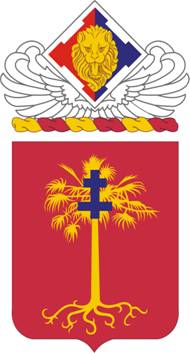
The 320th Field Artillery Regiment is a field artillery regiment of the United States Army. A parent regiment under the U.S. Army Regimental System, the 320th FAR currently has two active elements in the 101st Airborne Division : 1st Battalion, 320th FAR "Top Guns" in 2nd Brigade Combat Team; and 3rd Battalion, 320th FAR "Red Knight Rakkasans" in 3rd Brigade Combat Team. The regiment served with the 82nd Airborne Division during World Wars I and II, and regimental elements have served with the 82nd and 101st Airborne Division, the 193rd Infantry Brigade and the Berlin Brigade, and conducted combat operations in the Dominican Republic, Vietnam, Grenada, Operations Desert Shield and Storm, and the Global War on Terror.

The 321st Field Artillery Regiment is a field artillery regiment of the United States Army. A parent regiment under the U.S. Army Regimental System, the 321st FAR currently has one active battalion, the 3rd Battalion, 321st FAR, assigned to the 18th Field Artillery Brigade at Fort Bragg, NC. The battalion is equipped with M142 HIMARS.
The regiment served with the 82nd Division during World War I and with the 101st Airborne Division during World War II. Elements of the regiment have served with the 82nd and 101st Airborne Divisions in Vietnam, and with the 82nd Airborne Division and 18th Field Artillery Brigade during the Global War on Terrorism.
The 82nd Airborne Division Artillery (DIVARTY) is the divisional artillery command for the 82nd Airborne Division of the United States Army, stationed at Fort Liberty, North Carolina. It was organized in 1917, during World War I, was inactivated in 2006 as part of the transformation to modular brigade combat teams, and was reactivated in 2014.

The 326th Infantry Regiment was an infantry regiment of the United States Army that saw active service during World War I, as part of the 82nd Division and fought in the Meuse-Argonne Offensive and was inactivated in 1919. The regiment was reactivated during World War II, again as part of the 82nd Infantry Division, and was converted into a glider infantry formation, becoming the 326th Glider Infantry Regiment. Originally part of the 82nd Airborne Division, the regiment transferred to the 13th Airborne Division. However, despite training for almost three years, the 326th was never involved in any combat.



















